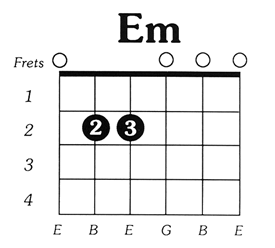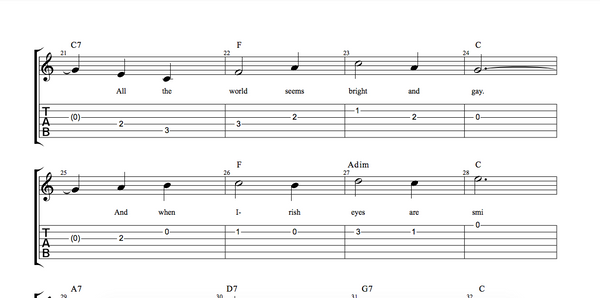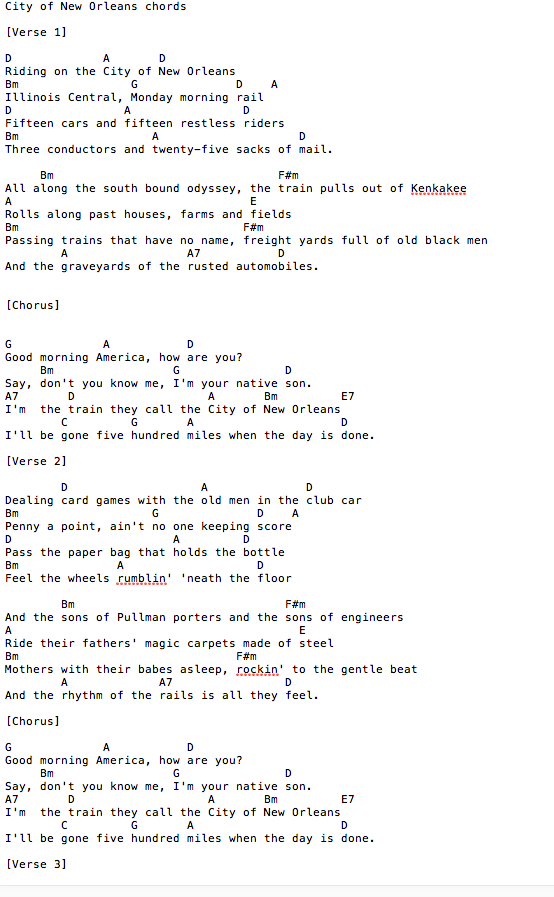Hey everybody, Bill Uhler here from The Music Gallery! I'm doing a series of lessons for beginner students and today, I wanted to talk a little bit about music notation. Most first-time students are learning a new instrument and also learning how to read notes for this instrument. There are a few different methods of notation for guitar and other stringed instruments that you should be aware of. They are chord diagrams, standard notation, tablature, and lead sheets.
Chord Diagrams
One of the most common things we might see as a beginner are chord diagrams. Basically, what you're looking at in a chord diagram is a picture of the guitar neck with the guitar facing you. The Vertical lines represent the strings, the horizontal lines represent the fret wires, and the numbers in the circle represent your fretting hand fingers. Above the little diagram there might be some some O's, which means that string is played open. There might also be an X which means to avoid hitting that string.

An E minor chord show circles with the numbers two and three. Two is on the fifth string and three is on the fourth string. For this E Minor chord, you'll press your second finger on the second fret of the fifth string and you'll press your third finger down on the second fret of the fourth string. Leave all the other strings open and strum! That's the E minor chord!
Standard Notation
Another way of notating guitar music is probably what most people have seen for a good part of their lives whenever they've looked at music. This is referred to as standard notation.

The five horizontal lines in this image are called the staff and the circles positioned along the staff are musical notes. It can be daunting to simultaneously learn where the notes are on the staff and on the guitar in the beginning, so I'll show you an easier way to start called Guitar Tablature .
Tablature - Overview
Tablature is very helpful. It tells you the location of each note on the guitar. The following example shows a staff of standard notation connected to a staff of tablature (indicated by "TAB" on the left side). The first note in standard notation is the G note. The tablature below shows the location of the G note on the third string and it is open.

In case you don't know what an "open" string is, a note played without pressing down any frets is called an open string.
Tablature - The Lines
In tablature, each line represents a string on the guitar. The top line would be the highest pitched string. Its the opposite of the way we look at the guitar. This means the notes on the top line are on your first string and the notes on the bottom line are on your sixth string. We count the strings from top down.
I know it looks backwards. I believe the reason why we do tablature this way is because of standard notation. When the notes are written on the bottom, those are the lowest notes - also called the bass notes. So they put the sixth string, which is the bass string, on the bottom of the tablature.
Always remember, the top line is your first string and the bottom line is your sixth string.
Tablature - The Numbers
The numbers in guitar tablature refer to which fret. The example above shows the first note as a zero on the third string. This means to play the third string open. The next note is the E note. It is played by pushing the second fret down on the fourth string and shown with the number two on the fourth line. The Third note is a C note. It is played at the third fret of the fifth string. The numbers and lines work together to show the exact location of each note.
Lead Sheets
Another common way of notating music for the guitar is with lyrics and chord symbols, which is also referred to as a lead sheet. The example below is a chord sheet for a song called City of New Orleans by Steve Goodman and Arlo Guthrie.
 You'll notice that there is no notation. No standard notation, no tabs, or anything like that. The only things noted on here are the chords. The chords are written above the lyrics where they would occur. In the line "Riding on the city of New Orleans", there is a D chord, followed by an A chord, and then back to a D Chord. So we would strum a D chord when we sing the word "Riding". We switch to the A chord on the word "City" and we would switch back to the D chord on "New Orleans". We just switch chords as they occur over the lyrics.
You'll notice that there is no notation. No standard notation, no tabs, or anything like that. The only things noted on here are the chords. The chords are written above the lyrics where they would occur. In the line "Riding on the city of New Orleans", there is a D chord, followed by an A chord, and then back to a D Chord. So we would strum a D chord when we sing the word "Riding". We switch to the A chord on the word "City" and we would switch back to the D chord on "New Orleans". We just switch chords as they occur over the lyrics.
We have a few different ways of notating music for the guitar. I know this can be confusing for a lot of people in the beginning, but it gets easier the more you look at it. It's kind of like learning a new language. The more you do it, the easier it gets.
I hope this lesson was informative and helpful. Once again I am Bill Uhler from the Music Gallery. If you have any questions or are interested in any lessons please let us know!
